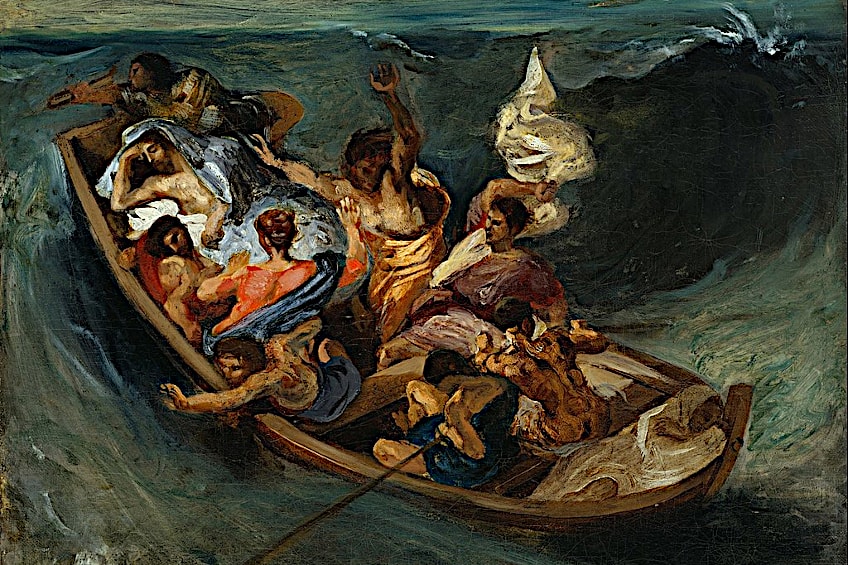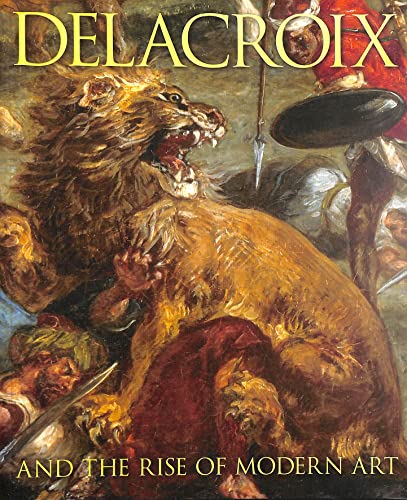Eugène Delacroix – Romantic Precursor of Early Modernism
Who was Eugène Delacroix and what role did he play in the history of art? Eugène Delacroix the artist is remembered as being the French Romantic school’s leader. French painter Delacroix differed from the Neoclassical artists in that he found it more important to focus on movement and color, instead of meticulously modeled forms and clear outlines. To find out more about Eugène Delacroix the painter, we will be taking an in-depth look at Eugène Delacroix’s biography and art style.
Contents
Exploring Eugène Delacroix’s Biography
| Full Name | Ferdinand Victor “Eugène” Delacroix |
| Nationality | French |
| Date of Birth | 26 April 1798 |
| Date of Death | 12 August 1863 |
| Place of Birth | Charenton-Saint-Maurice, Île-de-France, France |
In his mature period, Eugène Delacroix’s paintings were characterized by romantic and dramatic themes, however, he did not follow the traditional Greek and Roman classical modes but instead went to North Africa to discover exotic textures, colors, and subject matter.
French painter Delacroix was at heart an individualist, and he was neither nostalgic nor full of bravado – he wished to express passion in his artworks, yet executed that passion in a determined and cold manner in order to express it as clearly as possible.
Eugène Delacroix, the artist, was particularly influential on the Impressionists, who were significantly shaped by his study of color’s optical effects and expressive brushwork. Eugène Delacroix, the painter, also influenced the Symbolists, who embraced his love for the exotic.
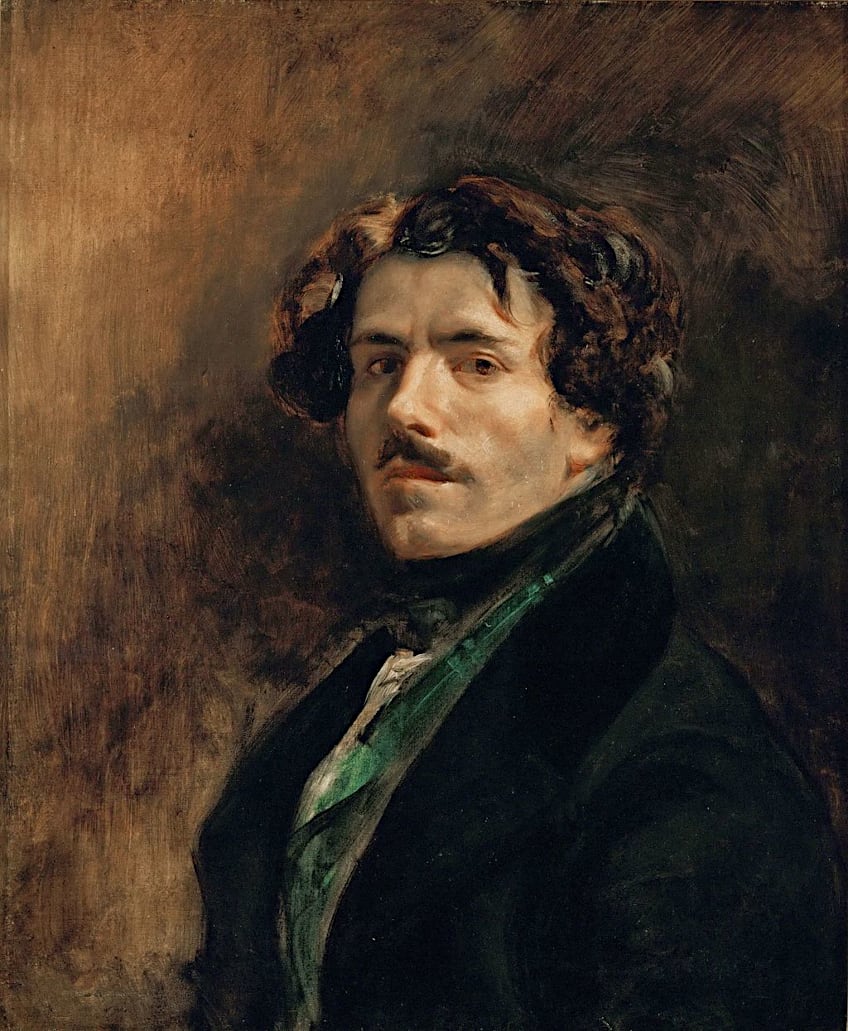
Early Life
Eugène Delacroix was born in a village on the outskirts of Paris in 1798. While it is known for certain that his mother was Victoire Oeben, there are doubts that her husband, Charles Delacroix, was the biological father as he had undergone surgery for a tumor that would have prevented him from being able to procreate. It is believed that his biological father was a family friend and a man that would eventually succeed Delacroix as Minister of Foreign Affairs.
Upon assuming his position as foreign minister, Tallyrand sent Eugène Delacroix to The Hague to serve as the ambassador of France in the Batavian Republic.
It is further believed that French painter Delacroix was commissioned to produce several artworks that were anonymously requested by Tallyrand himself. In fact, due to Tallyrand’s position, Eugène Delacroix the painter was always protected and looked after.
Early Training
After first attending Lycée Louis-le-Grand, he then went on to study at Lycée Pierre Corneille in Rouen, where he deeply immersed himself in the classic works and received multiple drawing awards. Following that, Pierre-Narcisse Guérin started training him in Jacques-Louis David’s Neoclassical style. The Virgin of the Harvest (1819), one of Delacroix’s first church commissions, exhibits the influences of Raphael.
The Barque of Dante (1822) was produced after French painter Delacroix was significantly influenced by The Raft of Medusa (1819) by Théodore Géricault and was accepted by the panel of the Paris Salon for their exhibition that year.
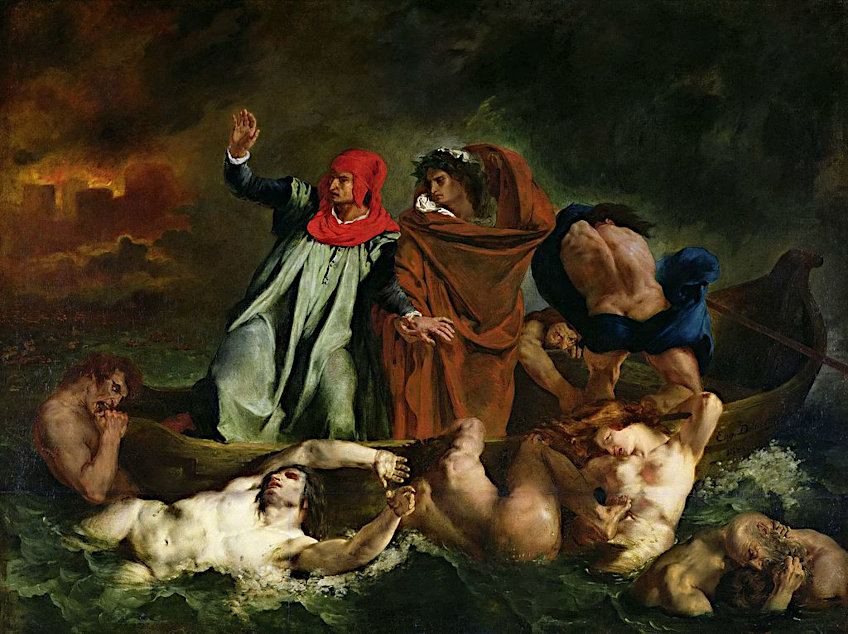
The painting was met with both public derision and academic contempt, yet was bought for the Luxembourg Galleries by the state – a pattern of rejection and acceptance that would persist throughout his career. It was also during this time that he experienced his first affliction of tubercular laryngitis which would end up being a source of constant concern for the artist all throughout his life. He even took to wearing a scarf in an attempt to stop it from occurring again – a look that established his fashionable appearance.
Early Career
One of Eugène Delacroix’s paintings, Massacre at Chios (1824), depicts a scene in which dying and ill Greeks are about to be executed by the invading Turks. The state recognized his talents and bought the artwork. It was largely met with controversy, with many critics deriding the work, as unlike usual paintings of this style, it did not depict a heroic moment, but rather a bleak and depressing image of suffering and death. While aspects of the artwork had a huge emotional impact on its viewers – such as the baby holding on to the body of its dead mother – many felt that it was not appropriate subject matter for a work of art. He then proceeded to make changes to the landscape and sky after seeing the works of Richard Parkes Bonnington and John Constable.
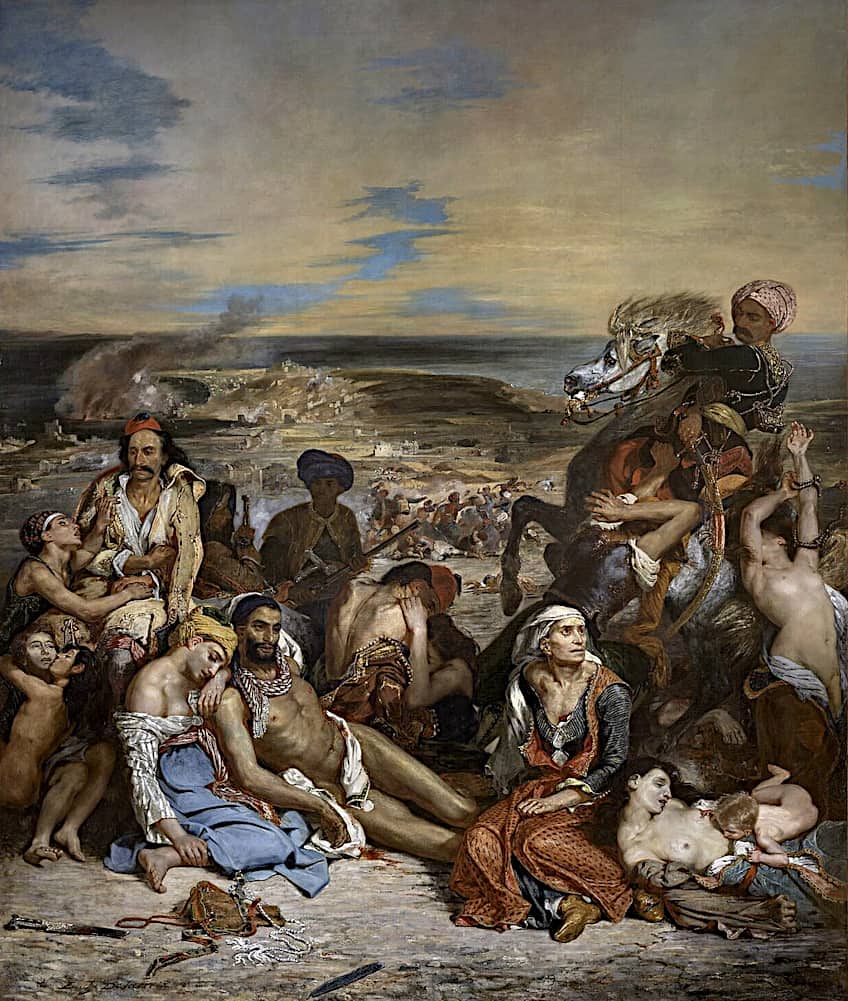
He then created a second artwork in support of the Greek war for independence, on this occasion referring to the Turkish seizure of Missolonghi in 1825. Greece Expiring on the Ruins of Missolonghi (1826) depicts a woman in Greek attire with her breast bared and her arms half-raised pleading in sorrow in front of the horrific scene: rather than ever surrendering to the Turks, the Greeks preferred to commit suicide and demolish their city. Produced to embody the notion of liberation from tyranny, it served as a commemoration of those who had perished. This tragedy captivated Delacroix, not only because he sympathized with the Greek citizens, but also due to the fact that the famous poet Byron, whom Delacroix profoundly respected, had passed away there too.
In 1825, he visited Richard Parkes Bonington and Thomas Lawrence in England, and the color and execution of English painting inspired his sole full-length portrait, the exquisite Portrait of Louis-Auguste Schwiter (1830).
Around the same time, he was producing romantic artworks on a range of subjects, many of which would captivate his interest for the next 30 years. By 1825, he was making lithographs of the works of Shakespeare, followed by paintings and lithographs of Goethe’s Faust. Works like Woman with Parrot (1827) introduced themes of cruelty and sexuality that would become recurring. The Death of Sardanapalus (1828) brought these diverse romantic elements together. Delacroix’s depiction of the death of Sardanapalus, the Assyrian monarch, portrays an emotionally charged situation filled with exotic clothes, exquisite colors, and horrific events. The besieged monarch observes stoically as guards carry out his instructions to slay his concubines, servants, and animals in The Death of Sardanapalus. The literary reference for this artwork is a play written by Byron, though the original play makes no mention of the slaughtering of concubines.
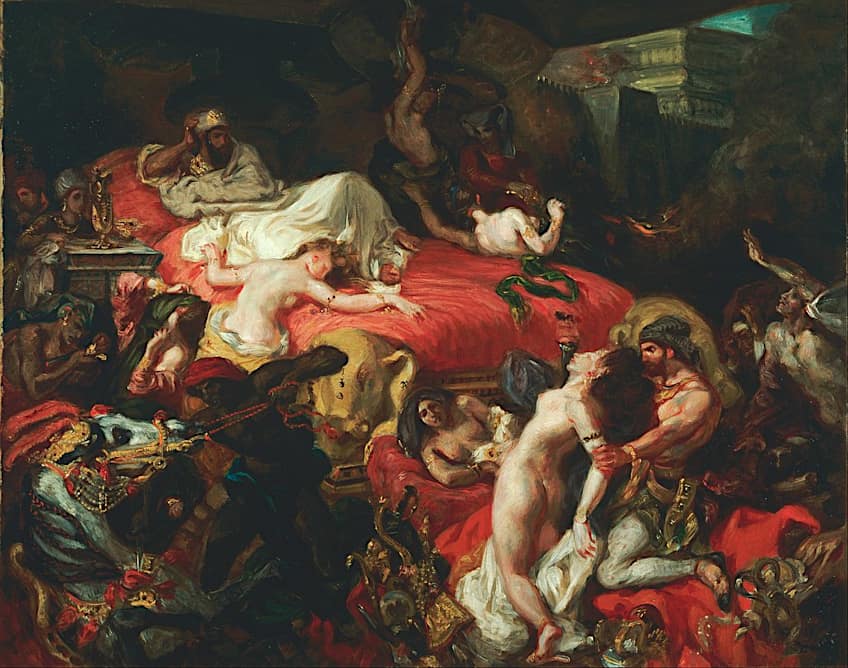
Sardanapalus’ cool detachment is a common posture in Romantic iconography from this time period in Europe. Some reviewers have described the artwork, which would not be displayed again for many years, as a horrendous vision featuring desire and death. The struggle of a naked woman whose head is about to be slit is particularly horrific, with the incident presented vividly in the center for maximum effect. Yet, the seductive beauty and exotic colors of the arrangement make the scene look both appealing and disturbing.
The Murder of the Bishop of Liège (1829) combined a number of Romantic themes. It, too, borrows from literary material, this one written by Scott, and illustrates an event set in the Middle Ages, that of Louis of Bourbon’s assassination during a feast sponsored by William de la Marck. The event occurs in a vast domed space that Delacroix had designed based on his various sketches of Westminster Hall and the Palais de Justice in Rouen, and is arranged around a brightly lighted stretch of tablecloth.
One critic characterized the image’s dynamic handling as being “less accomplished than a painting, more complete than a sketch” in 1855.
Mature Period
Delacroix’s most significant work, Liberty Leading the People, was completed in 1830, demonstrating the difference between the neoclassical and Romantic approaches regarding topic and technique. Liberty Leading the People, arguably Delacroix’s most iconic artwork, depicts the people of Paris picking up weapons and making their way under the banner of the tricolor, which signifies equality, liberty, and fraternity.
Even though Delacroix was influenced by current events to create this romantic impression of the true essence of liberty, he appears to be striving to communicate the intentions and character of the individuals instead of honoring the actual incident, the 1830 revolution against Charles X, something that did little more than usher in a different ruler, Louis-Philippe. The men lying dead in the front provides us with a devastating contrast to the iconic female figure, who is joyfully illuminated against a smoky background.
Although the French government acquired the artwork, officials thought its celebration of liberty to be too controversial and had it hidden from public view by 1832. Despite this, Delacroix obtained several state commissions for various ceiling paintings and murals. After the Revolution of 1848, which ended King Louis Philippe’s rule, Louis Napoleon displayed Delacroix’s artwork, Liberty Leading the People.

Delacroix traveled to North Africa and Spain in 1832 with Charles-Edgar de Mornay the diplomat as part of an envoy to Morocco upon the French conquest of Algeria. He traveled to observe a more “primitive” way of life, not to study art. Over the course of his career, he created over 100 drawings and paintings depicting scenes from or motivated by the lives of people in North Africa, contributing a fresh and intimate chapter to the ever-growing interest in Orientalism. Delacroix was fascinated by the people and their clothing, and the trip would have a significant impact on the themes of many of his later works.
Delacroix regarded the North Africans, in their clothing and demeanor, as visually comparable to the inhabitants of Classical Greece and Rome. Delacroix was able to draw some women discreetly in Algiers, however, he usually had issues locating Muslim women to model for him due to Muslim regulations compelling women to be concealed. Paintings portraying the North African Jewish women as models for the Jewish Wedding in Morocco (1841) were less challenging.
Delacroix produced numerous drawings of the inhabitants and the city while in Tangier, topics that he would return to for the rest of his life.
Later Period
Eugène Delacroix’s Medea About to Kill Her Children caused quite a stir at the Salon in 1838. This artwork, his first large-scale portrayal of a story from Greek mythology, features Medea holding her children, with her knife drawn to murder them in retribution for Jason abandoning her. The three naked figures create a dynamic triangle, illuminated in a streaming light that enters Medea’s grotto. Despite the fact that the artwork was swiftly acquired by the State, Delacroix was displeased when it was taken to the Lille Musée des Beaux-Arts; he had hoped it would hang in Luxembourg, along with his other works housed there.
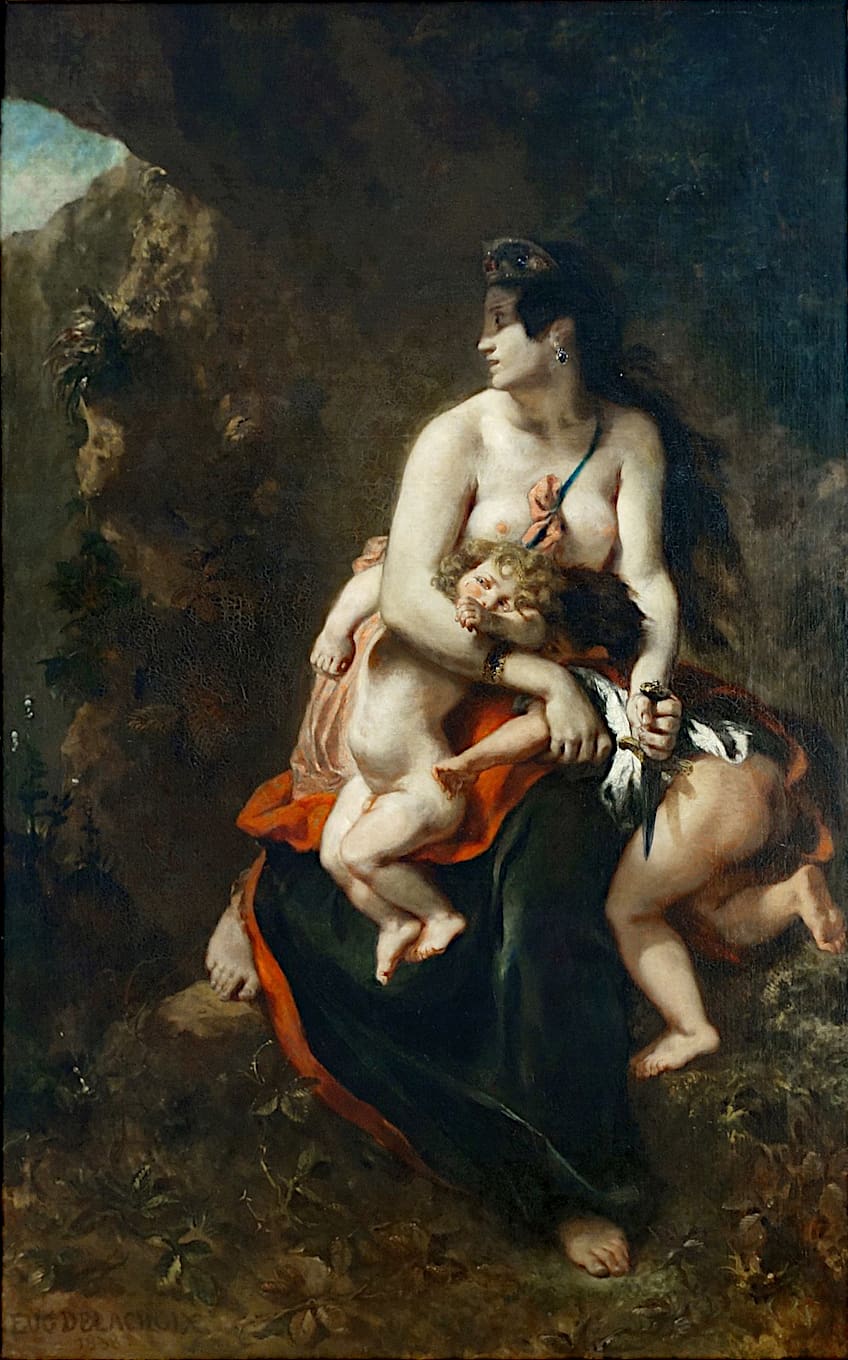
Delacroix, who was always a music and literature enthusiast, liked events that brought him into contact with the creative individuals of his time. For example, a request to paint her portrait led to friendships with the writer Georges Sand and her boyfriend Chopin, the famed composer. The author was known for wearing men’s clothing, and she did so for her painting, but Delacroix humorously advised her against it, stating that men could be villainous beasts.
In the last years of his life, Eugène Delacroix the artist sought inspiration from the natural world and produced many canvases depicting gardens with flowers.
Delacroix was commissioned by the city of Paris on multiple occasions to adorn public buildings from 1833 onwards. For the following 10 years, he painted in the libraries of the Palais Bourbon as well as the Palais du Luxembourg. These commissions provided him with the occasion to compose on a huge scale in an architectural context, much like his artistic influences Tintoretto, Paolo Veronese, and Rubens. The job was exhausting, and he developed a progressively weak constitution over the years. In addition to his residence near Paris, he resided in a little farmhouse in Champrosay beginning in 1844, where he found refuge in the countryside.
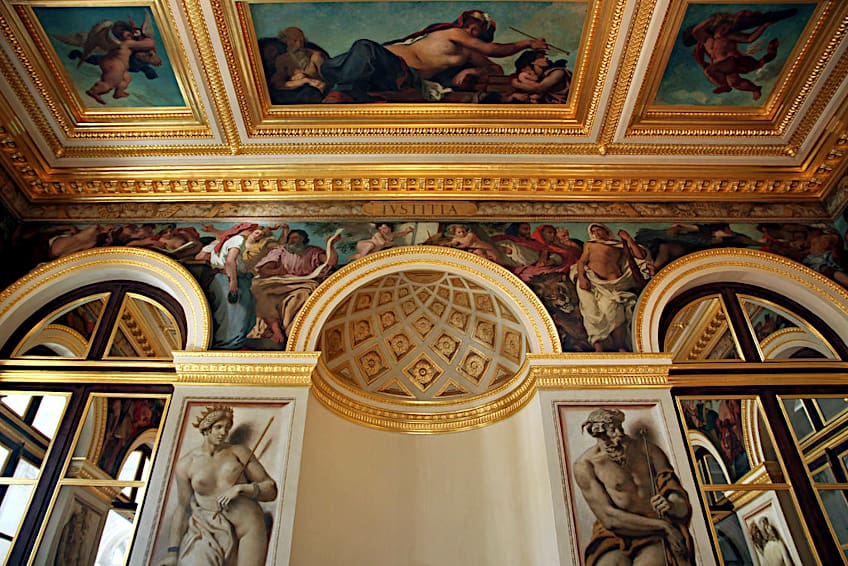
From 1834 until his passing, he was lovingly cared for by his domestic, Jeanne-Marie le Guillou, who fiercely protected his privacy and whose dedication lengthened his life and his ability to paint in his later years. His final decade was characterized by three significant decorative art commissions: the Hotel de Ville in Paris, the Galerie Apollon’s ceiling at the Louvre, and the Chapelle des Saints Anges at the Church of St Sulpice.
In 1855, he presented 48 works at the World Expo in Paris, and on his eighth application to the Salon in 1857, he was finally admitted as one of the Academy’s full members. Following this, he committed himself exclusively to the painting of St Sulpice, which he completed in 1861.
Delacroix then helped co-found the Société Nationale des Beaux-Arts in 1862. Along with Delacroix, the committee included artists Puvis de Chavannes and Carrier-Belleuse, and his friend, novelist Théophile Gautier, was appointed chairman. The society presented a comprehensive exhibition of Delacroix’s nearly 250 paintings and lithographs shortly after his passing in 1863 – and then stopped producing exhibits.
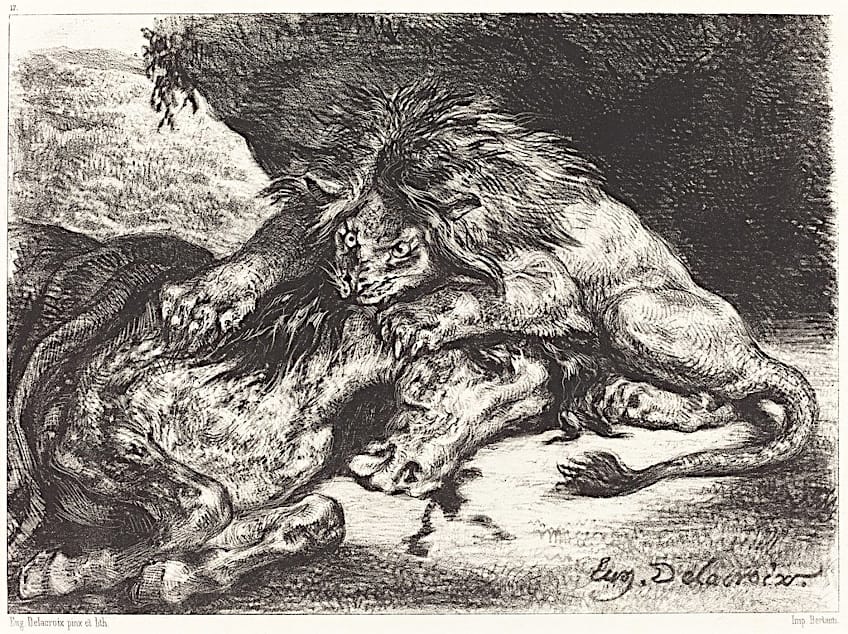
The winter of 1863 was particularly difficult for Delacroix, who was struggling with a severe throat illness that seemed to worsen throughout the season. By the 15th of July, he was unwell enough to see his physician, who told him there was nothing further he could do. He was only able to eat fruit at that point. Upon realizing how bad his health was, he drafted a will and left a gift for each of his close friends. He left enough money for his devoted housekeeper to survive on while instructing that everything in his workshop be sold.
Eugène Delacroix’s Legacy
Delacroix’s significance extends far beyond the Romantic movement, wherein he served a significant and innovative role. The Impressionists and subsequent Symbolists expanded on Delaroix’s treatment of the subject matter, emotion and expression, dramatic stances of his characters, expressive use of color, and study of natural light in his landscapes, to create some of the earliest modern art.
French painter Delacroix’s tonal division, particularly, would have a huge effect on the works of Impressionists such as Pissarro and Monet. Delacroix’s understanding of the significance of opposing tones ultimately led to Georges Seurat’s color theories.
Delacroix had a significant influence on these painters, and they commonly produced works that were inspired by some of his most well-known masterpieces, often even openly acknowledging the artist. Delacroix was the last of the great painters in the Italian High Renaissance tradition, and his penchant for big historical, mythological, theological, or literary works, as well as his highly decorative aesthetic, made him one of the early modern artists. His tachisme and the intensity of his colors laid the foundation for significant modern art styles like Expressionism and Fauvism. His art influenced a broad spectrum of painters, including the Impressionists Edouard Manet and Pierre Renoir; Edgar Degas even acquired a piece for his own collection.
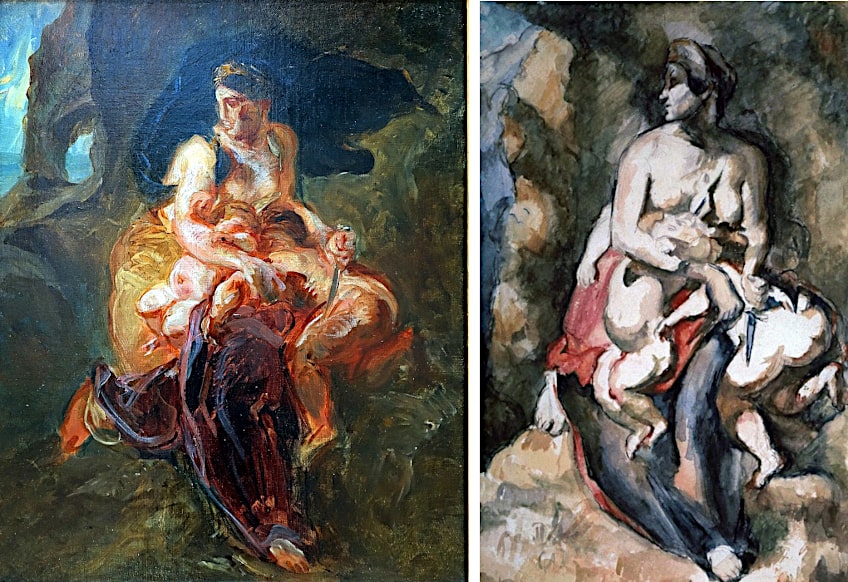
Charles Baudelaire, art critic, and Avant-Garde poet, who was renowned for his affinity for alcohol and opium, may have been Delacroix’s closest friend in the literary world. Baudelaire was a staunch supporter of the artist’s career and used his literature to promote his art. Baudelaire described him as a volcano skillfully concealed under flower bouquets, and that he was “passionate about passion”, and coldly driven to find the most conspicuous technique to express it.
Delacroix and Edgar Allan Poe, one of Baudelaire’s favorite authors, were regarded by the author as the leaders of the modern art movement as a whole as well as the Romantic movement.
Many artists also created visual tributes to Delacroix, such as Homage to Delacroix (1864) by Henri Fantin-Latour, which featured contemporary artists gathered around a painting of Delacroix as a gesture of respect for the debt they owed him. Delacroix’s impact extended well into the following century, as evidenced by The Women of Algiers, After Delacroix (1955) by Pablo Picasso. Picasso, who famously said, “That bastard, he’s really good”, spoke warmly of Delacroix and recognized his significant impact on contemporary art.
Eugène Delacroix’s Art Style
Many of Eugène Delacroix’s paintings exhibited at the Salon featured dramatic events from both literature and the contemporary history of his time. A number of the themes stunned audiences because of the brutality and explicit portrayal of human tragedy.
These artworks marked a shift in contemporary art, one that valued emotional expression over logic and order. Delacroix’s representations of animals perfectly represent Romanticism’s reverence for the untamed and wild.
These artworks were based on observations he made at Jardin des Plantes in Paris, where he drew the zoo’s lions, in addition to the sketches he produced of domesticated cats. His simple still lifes are outstanding in their application of composition and color harmony, demonstrating his ambition to master all artistic disciplines like a true master artist. These paintings would eventually have an impact on Impressionist painters who produced still-lifes in unique and modern ways.

Eugène Delacroix the painter obtained several large commissions in France to decorate churches and public buildings. He was able to produce on a larger scale than ever before because of these decorative projects, such wall murals, and ceiling paintings, and they had an impact on the Symbolists and the Nabis, who wanted to free art from the confines of the canvas. The aesthetic impact of Eugène Delacroix’s paintings is due in large part to his understanding of color; he comprehended ideas like contrast harmony and tonal division, both of which would be extremely significant for subsequent modernists such as Seurat and Van Gogh.
Delacroix’s main artistic adversary was the artist Jean-Auguste-Dominique Ingres. There was apparently a huge creative conflict at the time, which may be summarized as the dispute between the importance of line and color.
Ingres and the Neoclassicist school he was following from David regarded line as most essential in art, whereas Delacroix advocated for color. The two artists had a series of confrontations. According to one story, Ingres insisted that the Louvre Museum’s windows be opened in order to expel the “smell of sulfur” that Delacroix’s previous visit had presumably left behind – an allusion to the devil himself.
Eugène Delacroix’s Paintings
Eugène Delacroix was known for his optical effects and bold brushwork in his works of art. Titian, Peter Paul Rubens, and Caravaggio were Old Masters whose work served as an influence on Eugène Delacroix the artist. In addition, he prioritized movement and color in his works of art rather than only concentrating on modeled forms and distinct lines. As demonstrated by his works, the majority of his content was dramatic and romantic.

Throughout his career, the artist drew inspiration from a broad range of sources, including the classical literature of Lord Byron and William Shakespeare, as well as the skill of Michelangelo.
One aspect of his personality that endured from the start of his life till the end was a continuous yearning for music. He became one of the most intriguing and complex artists of the 19th century due to the unrestrained expression of vitality and movement in his paintings, the sensual virtuosity of his coloring, and his obsession with brutality, devastation, and the most tragic elements of existence. Here are a few of the most notable examples of Eugène Delacroix’s paintings.
| Artwork | Date | Medium | Dimensions (cm) | Location |
| Scenes from the Massacres of Chios | 1824 | Oil on canvas | 419 x 354 | The Louvre Museum, Paris, France |
| The Death of Sardanapalus | 1827 | Oil on canvas | 392 x 496 | The Louvre Museum, Paris, France |
| Liberty Leading the People | 1830 | Oil on canvas | 260 x 325 | The Louvre Museum, Paris, France |
| Women of Algiers in their Apartment | 1834 | Oil on canvas | 180 x 229 | The Metropolitan Museum of Art, New York City, United States |
| Apollo Slaying the Serpent | 1851 | Oil on canvas | 800 x 750 | The Louvre Museum, Paris, France |
| Christ on the Sea of Galilee | 1853 | Oil on canvas | 117 x 169 | The Metropolitan Museum of Art, New York City, United States |
| Lion Hunt | 1861 | Oil on canvas | 57 x 74 | The Art Institute of Chicago, Illinois, United States |
Book Recommendations
That covers Eugène Delacroix’s biography and art! However, you might be keen to learn even more about Delacroix’s life and artwork. Therefore, we have made a list of books that you might enjoy covering Eugène Delacroix’s paintings and lifetime. They will provide you with even deeper insight into the career of Eugène Delacroix the artist.
Eugène Delacroix and the Rise of Modern Art (2015) by Patrick Noon and Christopher Riopelle
Produced for the exhibition of the same name at the Minneapolis Institute of Art, the essays in this excellent catalogue trace the impact of Delacroix and French Romanticism on the early development of Modernism. The artistic legacy of the interactions between these artists and the impact of their works on one another is carefully traced and illustrated with illuminating examples. One highlight includes a discussion on Delcroix’s varied choice of subjects and technical innovations. The illustrations include artworks features in the blockbuster exhibition and even extend to additional artworks that were not on show. An ideal book far anyone who wants to gain a deeper understanding of Delacroix and his role in the history of Modern art.
- Excellent catalogue produced for the exhibition of the same name
- Includes 160 full-color illustrations of artworks by Delacroix and others
- Insightful essays provide in-depth insight into Delacroix and his legacy
Delacroix: New and Expanded Edition (2018) by Barthélémy Jobert
Jobert examines the inner conflicts and paradoxes that drove Eugène Delacroix the artist, bringing together decorative cycles, large canvases, watercolors, and engravings. By recreating the cultural and political contexts in which Delacroix prospered, Jobert allows readers to fully comprehend the exceptional breadth of his artistic output. He describes how Delacroix handled the Paris Salons and the corridors of power, mingled with Victor Hugo and George Sand, had lengthy philosophical conversations with Baudelaire concerning art, and kept up a dynamic dialogue with the press. He clearly illustrates Delacroix’s travels to Morocco, which unintentionally led him to rediscover his classical origins, and demonstrates how Delacroix impacted contemporary painters like Picasso and Cézanne. This amazing book by Jobert is now available in a revised, extended version with an entirely rewritten introduction and conclusion.
- Expanded edition includes updated introduction and conclusion
- Engaging biography that matches the fervor of its subject
- Vivid demonstration of Delacroix's influence on early Modernism
Journey to the Maghreb and Andalusia, 1832: The Travel Notebooks and Other Writings (2019) by Eugène Delacroix
Eugène Delacroix joined a French delegation to Morocco in 1832, the first part of a tour across Andalusia and the Maghreb that would leave an everlasting mark on the artist. This thorough English translation of his writings and notes from this crucial trip gives a classic example of historical travel writing about the “Orient”, as well as a unique image of the territory against the context of the French occupation of Algeria. Eugène Delacroix’s travels in Algeria, Morocco, and southern Spain introduced him to a society about which he had only flawed and clichéd views and presented him with a rich reservoir of images that fuelled his creativity for the rest of his life. Eugène Delacroix detailed his experiences, including the locations he visited, the routes he took, the scenery he observed, and the individuals he met, in a number of notebooks.
- First comprehensive and annotated translation of Delacroix's writings
- Provides rare insight into Delacroix's thought processes and creative motivations
- Ideal for historians of art, French North African colonialism, and travel writing
Eugène Delacroix’s experimentation with action scenes and color gave rise to Impressionism and other contemporary painting movements. When it came to his personal style, he preferred the dramatic themes associated with the Romanticism movement, of which he was potentially its greatest proponent. The Symbolists were also highly influenced by his style – specifically his attention to expression and emotion. His utilization of colors would also have a huge impact on the Fauvists, among many other movements and artists.
Take a look at our Eugène Delacroix paintings webstory here!
Frequently Asked Questions
Who Was Eugène Delacroix, and What Was He Famous For?
Eugène Delacroix was an artist from France who played a major role in the development of the Romantic movement. Delacroix studied under the English Romantic landscape artists, and adapted their techniques to create a fresh and distinctive approach to color. His natural creative aptitude, along with the influence of historical events, literature, and contemporary issues, produced an intense viewing experience on canvas. The surroundings influenced his works as well; he toured around Europe, but Morocco proved to have the most influence on him of all the countries he visited.
Was Eugène Delacroix the Painter Famous in His Lifetime?
Eugène Delacroix had a long and productive career, receiving numerous state commissions. His paintings were always viewed as contentious. Some contemporary reviewers were confused and disturbed by his harsh subject matter, strong passion, and vibrant colors, while others admired him deeply. Eugène Delacroix’s paintings revolutionized the world of art, and the Impressionist and post-Impressionist styles certainly benefited from his innovative painting style. Eugène Delacroix is recognized today as one of the most well-known French Romantic artists in the world, with his expertise and talent universally acknowledged and admired by contemporary art critics.
Liam Davis is an experienced art historian with demonstrated experience in the industry. After graduating from the Academy of Art History with a bachelor’s degree, Liam worked for many years as a copywriter for various art magazines and online art galleries. He also worked as an art curator for an art gallery in Illinois before working now as editor-in-chief for artfilemagazine.com. Liam’s passion is, aside from sculptures from the Roman and Greek periods, cave paintings, and neolithic art.
Learn more about Liam Davis and about us.
Cite this Article
Liam, Davis, “Eugène Delacroix – Romantic Precursor of Early Modernism.” artfilemagazine – Your Online Art Source. September 12, 2023. URL: https://artfilemagazine.com/eugene-delacroix/
Davis, L. (2023, 12 September). Eugène Delacroix – Romantic Precursor of Early Modernism. artfilemagazine – Your Online Art Source. https://artfilemagazine.com/eugene-delacroix/
Davis, Liam. “Eugène Delacroix – Romantic Precursor of Early Modernism.” artfilemagazine – Your Online Art Source, September 12, 2023. https://artfilemagazine.com/eugene-delacroix/.


